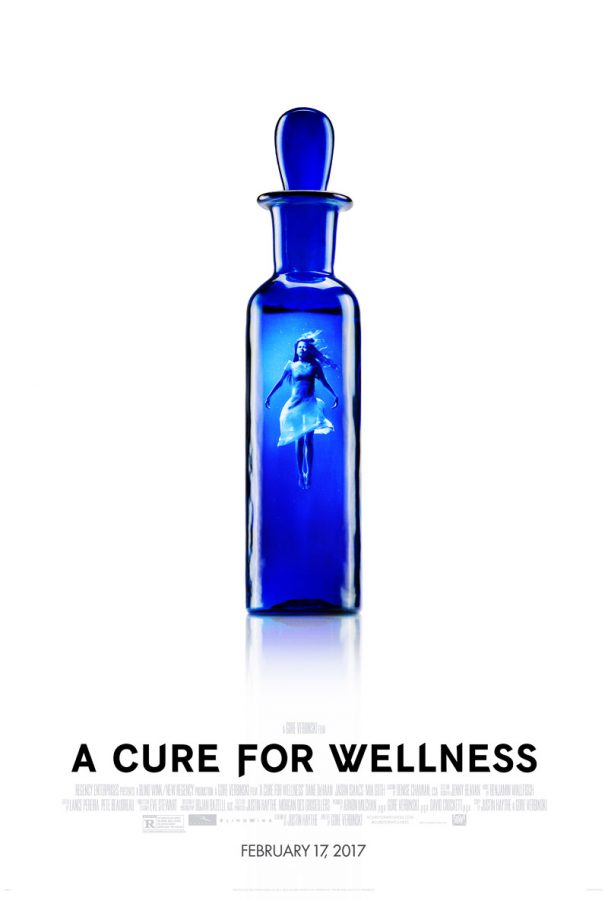A cure is needed for ‘Wellness’
Institutionalized for its prominent lack of insane terror, while converging at the point of sheer boredom, the science fiction psychological horror thriller “A Cure for Wellness,” released last month, ushered moviegoers to seek asylum from the grueling ‘treatment’ they paid to endure.
The story revolves around Lockhart (Dane DeHaan): a young, executive Wall Street stockbroker tasked with the mission of retrieving his finance company’s CEO, Roland Pembroke (Harry Groener), from an elusive paradisal rehabilitation center in the Swiss Alps. Demanded by the company’s board members, Lockhart sets out on his own to convince Pembroke to return and sign off on an impending merger deal. Upon arriving at the medieval castle turned wellness spa, Lockhart seeks out Pembroke, assured later on by the institution’s Deputy Director (Adrian Schiller) that he will be ready to depart from the center later on that day. Sensing the surreptitious behavior lurking behind the spa’s inhabitants, Lockhart leaves for the nearest hotel only to be involved in a serious car accident on the road leading down from the castle.
He is admitted into the institution on the account of his injuries and is prescribed by the head director, Dr. Heinrich Volmer (Jason Isaacs), a treatment for his eroded health.
Put forth from the hackneyed genre of blissfully macabre institutions being aligned by darker, more sinister influences, “A Cure for Wellness” succeeds in exacting two and a half torturous hours out of a basic plotline. The story, branching from the film’s fictitious historical context, renders the underlying tone to be another regurgitated rendition of an old folk tale turned reality. While a novel representation of its own history, the motion picture has little to provide in the form of sustenance; its seemingly lackluster facade drives the exposition in a state of unbridled monotony, with each scene make a painstaking attempt as to uncover the blatant experiments the rehab spa conceals. Later on to be solely immersed within the confined space of a man’s obsession with a past love, the plot culminates beneath tedious actions of an ancient madman and his caring sociopathic tendencies. The psychological spectrum in contained within the boundaries of hallucinations and past depression, yet its attempt to exact the sensation of dismay falls short. Both the themes of horror and science fiction are almost nonexistent, with the only indications being the utilization of ominous music and the science behind the age of two characters. As the plot then falls to become another trite asylum flick, the film succeeds in bringing to fruition a fast remedy for views suffering with insomnia.
Subsequent to the excruciating development, the acting was fitting throughout its entirety. While nothing phenomenal, Dehaan’s exhibition of Lockhart’s cold and distressed disposition, or Isaacs’ portrayal of the furtive medical director, the characters were represented well amidst a crumbling story. Although, at times the portrayals seemed to lack originality, with individuals like Volmer coincidentally knowing every single shred of information on Lockhart, the occurrence is too overused. Hannah (Mia Goth) remained the only patient of the entire rehab center that contained the most interesting background, while Lockhart depicts more of the repetitive angsty young businessman whose life leaves him devoid of all feeling. In all, the acting was suitable alongside the hollow storyline it adhered to.
As its only redeeming quality, the movie’s cinematography remains marvelous in comparison. The style, exposing the minute intricacies of the castle’s stark white hospital interior and its patients, provides a remarkable mystique to the ultimately flat plotline. Resembling a more intensified ‘American Horror Story-esque’ experience, each insignificant detail is expanded upon and given an artistic flair to a seemingly eerie setting. While not enough to save the overall execution, the filming does succeed in the exhibition of its aestheticism and founding qualities.
In all, “A Cure for Wellness” exhibits a poor excuse of a plot and languid character development behind its extraordinary filming style. Dissolving the central motifs of science and dismay in a bleak of jumpscares, eerie music and menacing discoveries, the motion picture resolves only to provide a repeat the same general story. Its only success lies in leaving viewers with a feeling of nausea.









